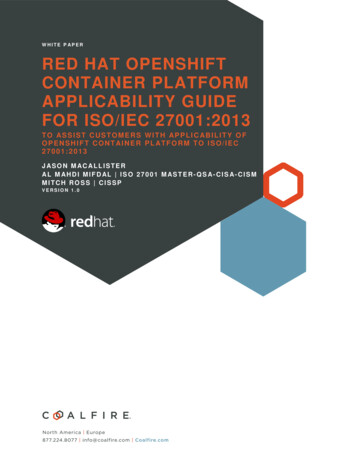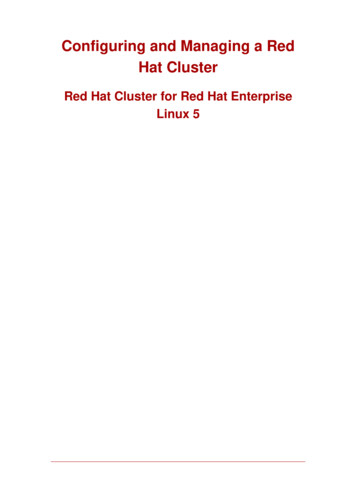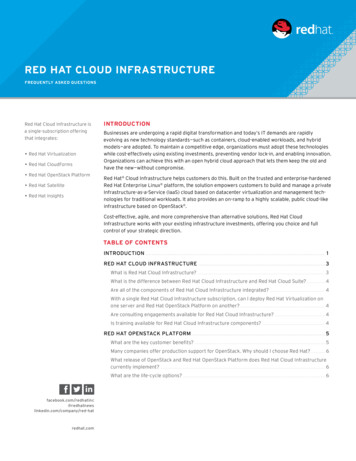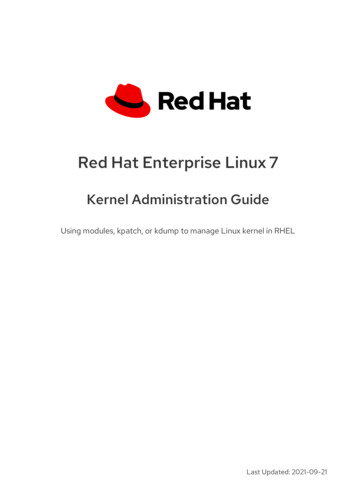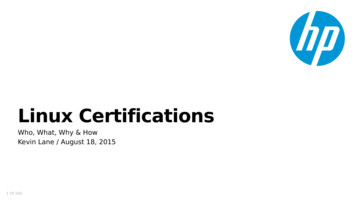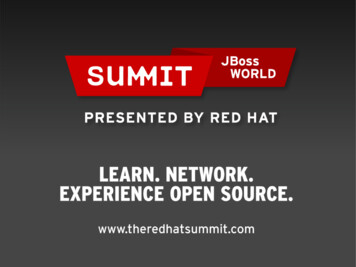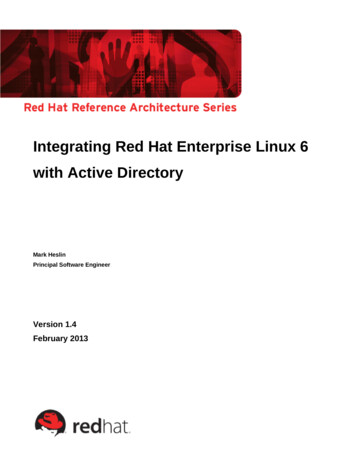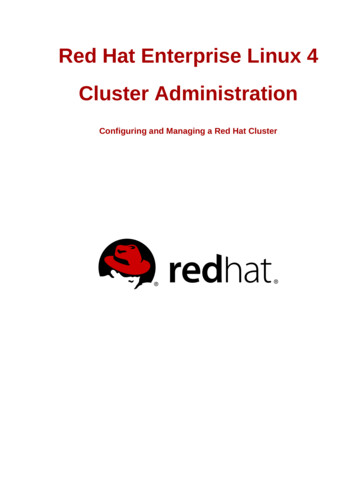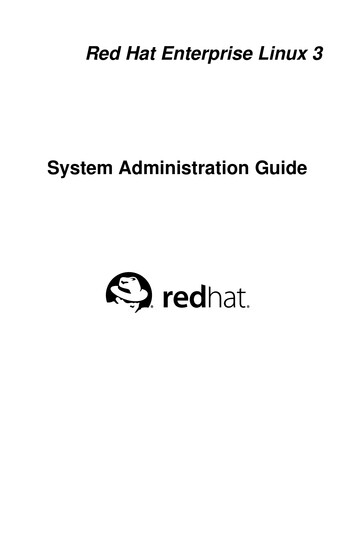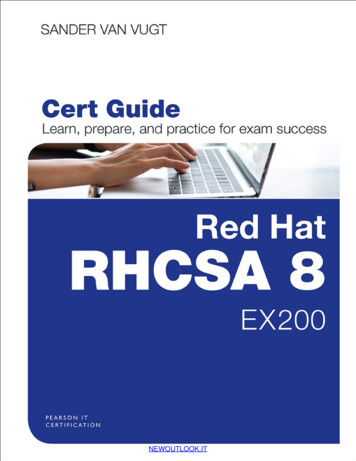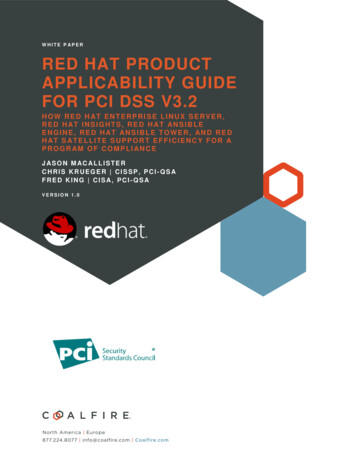
Transcription
W HITE P AP E RRED HAT PRODUCTAPPLICABILITY GUIDEFOR PCI DSS V3.2H O W R E D H AT E N T E R P R I S E L I N U X S E R V E R ,R E D H AT I N S I G H T S , R E D H AT AN S I B L EE N G I N E , R E D H A T AN S I B L E T O W E R , AN D R E DH AT S AT E L L I T E S U P P O R T E F F I C I E N C Y F O R AP R O G R AM O F C O M P L I AN C EJ AS O N M AC AL L I STE RCHRIS KRUEGER CISSP, PCI-QSAFRED KING CISA, PCI-QSAVERSION 1.0
TABLE OF CONTENTSExecutive Summary . 3Coalfire Opinion . 3Introducing PCI DSS v3.2 . 4Understanding PCI DSS Purpose and Scope. 4Scoping and Segmentation . 5A Program of Continuous Compliance . 5Suggestions for Use of this Report . 5Introducing Red Hat Solutions . 5Enterprise Platform for the Modern Data center . 6Red Hat Enterprise Linux Server . 6Management Tools to Support and Maintain a Program of Compliance .13Red Hat Insights .13Red Hat Satellite .14Red Hat Ansible Tower and Red Hat Ansible Engine .17A Combined Solution for Supporting Security and Compliance Objectives .18Coalfire Scope and Approach for Review .18Scope of Technology and Standard to Review .19Coalfire Evaluation Methodology .19Additional Considerations .20Red Hat Applicability to PCI DSS v3.2 .20Coalfire Conclusion .36References .37Bibliography .37Red Hat Product Applicability Guide for PCI DSS 3.2 White Paper2
EXECUTIVE SUMM ARYRed Hat, Inc. (Red Hat) delivers a comprehensive portfolio of enterprise grade software products andservices built from open source software components using an affordable, predictable subscription andsupport model. Red Hat engaged Coalfire, a respected Payment Card Industry Qualified Security Assessor(PCI QSA) company, to conduct an independent technical assessment of Red Hat Satellite, Red HatInsights, Red Hat Ansible Engine, Red Hat Ansible Tower, and Red Hat Enterprise Linux Server. Theprimary purpose of this product applicability guide is to identify alignment of technical control capabilities ofthe Red Hat products to the Payment Card Industry Data Security Standard (PCI DSS) v3.2 technicalrequirements.Coalfire’s reviewed these products individually and as a combined solution with respect to how they maybe useful in supporting a payment entity’s PCI DSS v3.2 compliance initiatives. Beyond requirementapplicability alignment, Coalfire also examined how the aggregated solution may be useful to addresschallenges for maintaining a program of compliance through centralized system lifecycle management,operational and security insights, and automated remediation. These capabilities can support improvedconfiguration consistency in alignment with compliance requirements.This product applicability guide may be useful to a payment entity looking for ways to improve management,insights, and control over infrastructure and application life cycles in support of PCI DSS v3.2 compliance.Further, this paper may also be useful to understand how these enterprise tools can be used to support aPCI DSS v3.2 program of compliance. This paper identifies and discusses PCI DSS v3.2 requirements thatmay be addressed by both the individual and combined capabilities of Red Hat Enterprise Linux Server,Red Hat Satellite, Red Hat Insights, and Red Hat Ansible Engine and Red Hat Ansible Tower.C O AL F I R E O P I N I O NCoalfire determined that Red Hat Enterprise Linux Server can be an effective platform for use in PCI DSSv3.2 assessed environments. Red Hat Enterprise Linux Server comes integrated with many securityfeatures and functions that effectively support numerous PCI DSS technical control requirements.Alongside Red Hat Enterprise Linux Server, Red Hat Satellite, Red Hat Ansible Engine, and Red HatAnsible Tower can be powerful tools to assist organizations with centralized management and control ofsystems and applications throughout their lifecycle. The lifecycle management capacity of these tools canassist organizations with maintaining a state of continuous compliance and demonstration of theorganization’s business as usual technical compliance activities. Many routine tasks carried out on systems,from provisioning through remediation, can be automated to increase efficiency and further enable systemwide compliance consistency.Finally, Red Hat Insights is a valuable service for providing visibility into the increasingly complex ITenvironments, enabling security and operations teams to proactively identify and respond to issues thatcan impact performance, availability, security, and compliance. Likewise, system health and configurationmonitoring through Red Hat Satellite can help to ensure that systems are in alignment with organizationalstandards and are compliant with PCI DSS 3.2 technical requirements.Red Hat Product Applicability Guide for PCI DSS 3.2 White Paper3
INTRODUCING PCI DSS V3.2The Payment Card Industry Security Standards Council (PCI SSC) was founded in 2006 by AmericanExpress, Discover, JCB International, Mastercard, and Visa Inc. to serve those who work with and areassociated with payment cards. The mission of the PCI SSC is twofold; first, to help merchants and financialinstitutions understand and implement standards for security policies, technologies, and ongoing processesthat protect their payment systems from breaches and theft of cardholder data (CHD); second, to helpvendors understand and implement standards for creating secure payment solutions. PCI DSS v3.2 is aframework that defines baseline physical, technical, and operational security controls, defined asrequirements and sub-requirements, necessary for protecting payment card account data. PCI DSS definestwo categories of payment card account data: CHD, which includes primary account number (PAN),cardholder name, expiration date, and service code; and sensitive authentication data (SAD), whichincludes full track data (magnetic stripe or equivalent on a chip), card security code(CAV2/CVVC2/CVV2/CID), and personal identification numbers (PINs/PIN blocks) entered during thetransaction.U N D E R S T AN D I N G P C I D S S P U R P O S E AN D S C O P EA reliable approach for determining where PCI DSS is required to be applied begins with identification anddefinition of scope for review. As stated on page 5 of the PCI DSS Requirements and Security AssessmentProcedures, Version 3.2, April 2016, PCI DSS applies to any organization that stores, processes, ortransmits CHD. These organizations include, but are not limited to: merchants, payment processors,issuers, acquirers, and service providers. The PCI DSS security requirements apply to all systemcomponents included in or connected to the cardholder data environment (CDE). The CDE is comprised ofpeople, processes, and technologies that store, process, or transmit CHD or SAD (PCI Security StandardsCouncil, 2016). PCI DSS defines twelve requirements designed to address six objectives, as show in thehigh-level overview displayed in Table 1.OBJECTIVESREQUIREMENTSBuild and Maintain aSecure Network andSystems1.Install and maintain a firewall configuration to protect cardholder data2.Do not use vendor-supplied defaults for system passwords and other securityparametersProtect Cardholder Data3.Protect stored cardholder data4.Encrypt transmission of cardholder data across open, public networks5.Protect all systems against malware and regularly update anti-virus software orMaintain a VulnerabilityManagement Programprograms6.Develop and maintain secure systems and applicationsImplement StrongAccess ControlMeasures7.Restrict access to cardholder data by business need to know8.Identify and authenticate access to system components9.Restrict physical access to cardholder dataRegularly Monitor andTest Networks10. Track and monitor all access to network resources and cardholder dataMaintain an InformationSecurity Policy12. Maintain a policy that addresses information security for all personnel11. Regularly test security systems and processesTable 1 - PCI DSS - High-Level OverviewRed Hat Product Applicability Guide for PCI DSS 3.2 White Paper4
S C O P I N G AN D S E G M E N T A T I O NPCI DSS recommends that an assessed entity confirm the accuracy of their PCI DSS scope at leastannually or prior to the annual assessment. To help identify scope, the payment entity should evaluate theirsystems to identify all locations and flows of CHD and identify all systems that are connected to or, ifcompromised, could impact the CDE. Systems that store, process, or transmit CHD/SAD are categorizedas CDE systems. Likewise, system components that reside on the same network segment (for example,same subnet or VLAN) as systems that store, process, or transmit CHD/SAD are considered “CDESystems”. A second category in scope for assessment is “Connected-to or Security-impacting Systems”. Athird category of systems as defined by PCI DSS is called “Out-of-Scope Systems”. Out-of-scope systems,by definition, are typically not considered in scope for assessment; however, it is important to understandthat any system that is part of a payment entity’s infrastructure can potentially, through vulnerability or lackof adequate security control, provide a foothold to a zone of the payment entity’s internal network, whichmay be used to, over time, pivot and acquire increasing access until CHD is eventually compromised (PCISecurity Standards Council, 2016).PCI DSS recommends the use of network segmentation to isolate the CDE from the remainder of an entity’snetwork as a method to reduce the scope of PCI DSS assessment, the cost of a PCI DSS assessment, thecost and difficulty of implementing and maintaining PCI DSS controls, and the risk to an organization byconsolidating CHD into fewer, more controlled locations. The intent of segmentation is to preventtraditionally out-of-scope systems from being able to communicate with systems in the CDE and/or impactthe security of the CDE (PCI Security Standards Council, 2016).A P R O G R AM O F C O N T I N U O U S C O M P L I AN C EPCI DSS specifies a best practice for implementing PCI DSS into Business-as-Usual (BAU) processes.These best practices are designed to ensure that prescribed security controls continue to be implementedproperly, to monitor the effectiveness of security controls on an ongoing basis, and to maintain an entity’sPCI DSS compliant environment in between PCI DSS assessments. The recommended best practices forimplementing BAU processes include monitoring of security controls, ensuring that failures in securitycontrols are detected and responded to in a timely manner, and reviewing changes to the environment thatmay impact PCI DSS scope, changes to organizational structure, and the performance of periodic reviews(PCI Security Standards Council, 2016).SUGGESTIONS FOR USE OF THIS REPORTThis white paper is intended to be used by a variety of payment card entities and other interested partiesthat may be involved in the sale, construction, operation, or assessment of infrastructure using Red HatEnterprise Linux, Red Hat Satellite, Red Hat Insights, Red Hat Ansible Engine, and/or Red Hat AnsibleTower. It guides Red Hat customers with understanding how these solutions can be used to support aprogram of compliance. It provides examples of how this assessment may be utilized by the identifiedentities engaged in a PCI DSS lifecycle including merchants and financial institutions; payment solutionservice providers; Infrastructure as a Service (IaaS) and Platform as a Service (PaaS) service providers;designated entities and others who share responsibility with a payment entity; and PCI DSS QSAs.INTRODUCING RED H AT SOLUTIONSRed Hat is the world’s leading provider of open source solutions, using a community-powered approach toprovide reliable and high-performing cloud, virtualization, storage, Linux, and middleware technologies. Thetransparency of Red Hat’s open source community-powered approach enables a greater scope of designdiversity than alternative closed development approaches. Due to this transparency, open source solutionshave the propensity to be more inherently secure. A larger community of developers and users are able toRed Hat Product Applicability Guide for PCI DSS 3.2 White Paper5
identify and correct discovered flaws on a more timely basis. Beyond this collaborative approach todelivering an enterprise operating platform and tools, Red Hat offers support, training, and consultation tohelp their customers successfully utilize the solutions that Red Hat provides.E N T E R P R I S E P L A T F O R M F O R T H E M O D E R N D AT A C E N T E RA platform for a modern data center should be able to keep up with the diverse demands of entities thatplan to use it. It should be adaptable, flexible, and sustainable to support ongoing hardware innovations. Itshould be able to support a diverse set of applications and business solutions with a wide array of deliveryoptions efficiently, effectively, reliably, and securely across private, public, and hybrid clouds. As anenterprise solution, it should be a consistent and stable platform. It should also be backed by support, tools,and solutions to optimize IT using the entity’s existing resources. Ideally, the platform should be designedwith security at the inception.The security built into the platform should be adaptable to address the ever-changing and constantlyevolving threat landscape. Simply protecting the entity’s boundary between “trusted” internal networks and“untrusted” or “unmanaged” external networks is no longer sufficient. Attackers are increasingly findingways to gain access to the internal network, often through insider access, and once inside can often pivotundetected across the “trusted” network. Placement of security controls closer to the sensitive or criticaldata is a way to reduce this risk. A zero-trust architecture, through well planned and executed accesscontrols (least access), network controls, eliminating unnecessary services (least function), use ofcryptography, and other security techniques, is useful to minimize the surface area of attack for internalassets and make it more difficult for attackers to find and gain access to protected data. The concept of azero-trust architecture assumes that a breach has already occurred and uses controls to minimize theimpact of that breach. Red Hat Enterprise Linux Server includes hardening guidance, as well as severalsecurity control features that are useful to support a zero-trust architecture.Red Hat Ent erprise Linux ServerThe foundation of Red Hat’s offering is Red Hat Enterprise Linux Server. There is broad applicability forRed Hat Enterprise Linux Server as a platform to serve various business applications and componentsincluding, but not limited to, traditional bare metal servers, hypervisors, virtual machines, and containerplatforms. The discussion of Red Hat Enterprise Linux Server for this paper is broad, but the securityfeatures, functionality, and capabilities are applicable across many of the use cases. For the purpose ofthis paper, Coalfire considers the use of Red Hat Enterprise Linux Server as a possible component of apayment entity’s CDE, which may have a role in storing, processing, or transmitting CHD/SAD, and/or asupporting system.Red Hat Enterprise Linux Server is a platform capable of supporting a multitude of application architectures.It provides fundamental core operating system functions including hardware resource managementcapabilities to orchestrate an infrastructure’s basic computing requirements including CPU, memory,network, and storage. Beyond the traditional operating system basics, Red Hat has incorporated a numberof security features and functions that are useful for entities looking to improve security or support variouscompliance initiatives.Red Hat provides guidance for securing Red Hat Enterprise Linux Server, which can be useful for securityand operations personnel planning for secure deployments of the operating platform. These hardeningguides are broken out by topics that align with general security best practices and common requirementsfound within various compliance frameworks. The guidance provided by Red Hat for Red Hat EnterpriseLinux Server is applicable and useful in general to varying degrees for aligning with PCI DSS requirements1, 2, 3, 6, 7, 8, 10, and 11. Detailed alignment can be found later in this document.Red Hat Product Applicability Guide for PCI DSS 3.2 White Paper6
In addition to hardening best practices, Red Hat has incorporated a number of available security featuresand functions into Red Hat Enterprise Linux Server. These features, when implemented, can help toimprove the management and functional security of the server platform across various deployment modes.Some of the integrated security features and functions that may be useful in a PCI DSS regulatedenvironment include disk and file level encryption, encryption for data in transit, Advanced IntrusionDetection Environment (AIDE), Domain Name System Security Extension (DNSSEC), USBGuard, MediaAccess Control Security (MACsec), Security Enhanced Linux (SELinux), identity management (IdM),compliance and vulnerability scanning with Open Security Content Automation Protocol (OpenSCAP),system auditing, firewalld, and iptables.Data-At-Rest Disk EncryptionRed Hat Enterprise Linux Server provides a number of data encryption options either for data at rest ordata in transit. Many of the requirements in PCI DSS v3.2 are applicable to how the payment applicationand/or payment hardware handle encryption and how the payment entity generates and secures encryptionkeys for the protection of CHD and SAD. While the encryption provided by Red Hat Enterprise Linux Serverdoes not specifically address all of the requirements and methodologies as it pertains to secure paymentapplication design, it can be useful for providing additional layers of security for specific use cases. RedHat Enterprise Linux Server complies with the Federal Information Processing Standard (FIPS) Publication140-2 and can be made compliant with the standard by enabling FIPS mode on the server.For data at rest, Red Hat Enterprise Linux Server includes Linux Unified Key Setup-on-disk-format (LUKS)disk encryption for full disk or partition encryption. This is useful for securing the contained data on diskwhen the server is powered off, when the disk is removed, or for removable media. Multiple ciphers, ciphermodes, and initial vectors are supported for enabling at-rest encryption on the server. Red Hat EnterpriseLinux Server also offers Policy Based Decryption (PBD) one of the implementations of which is calledNetwork Bound Disk Encryption (NBDE). NBDE allows for entire disks to be encrypted, including the bootdisk. For NBDE encryption, the target server enrolls with a remote server where the keys for encryption anddecryption are stored. The server involved with managing the keys and encryption for servers are thenetwork is needed in order for the disks to be decrypted. The entity can set up NBDE such that disks areunaccessible or unbootable and incapable of being decrypted if removed from the facility or from the systemon the network segment where NBDE is being used. The following steps outline the process for encryptionor decryption of disks using NBDE:1. Phase 1: Enrollmenta. During this phase the encryption key for the LUKS volume is encrypted with the public key ofthe remote decryption server.This operation can occur without direct access of the server.2. Phase 2: Decryptiona. The client generates a random key and wraps already encrypted volume key with a specialcryptographic operation. Then it sends the results to the serverb. The server decrypts the payload by removing the PKI encryption but the content is stillencrypted with the wrapping key so the server does not see the actual data.c.The client receives the response from the server and decrypts the payload to get direct accessto the key.d. The client then uses the key to unlock and mount the volume.Red Hat Product Applicability Guide for PCI DSS 3.2 White Paper7
On the client side is the Clevis framework. On the server side, on the network, is the system that will dothe remote unlocking that utilizes a TANG service. Figure 1 illustrates the components of NBDE for networkbased encryption and decryption of disks.Figure 1: NBDE Encryption ComponentsData-in-Transit EncryptionFor transmitted data, Red Hat Enterprise Linux Server provides options for securing communication eitherusing secure virtual private networks (VPNS), secure shell (SSH) with OpenSSH, OpenSSL, and stunnel.In Red Hat Enterprise Linux Server, VPNS can be configured using the IPsec tunneling protocol for hostto-host and/or site-to-site. SSH with OpenSSH provides a secure connectivity tool for remote login with theSSH protocol. OpenSSH encrypts traffic to protect against eavesdropping, connection hijacking, and otherattacks. OpenSSL is a library that provides cryptographic protocols to applications. The stunnel program isan encryption wrapper between a client and a server. It listens on the port specified in its configuration file,encrypts the communication with the client, and forwards the data to the original daemon listing on its usualport. This way, any service can be secured where the service itself does not support any type of encryption.Likewise, it can be used to improve the security of a service that uses a type of encryption that is not strongenough for the specific application, for instance SSL version 3 affected by the POODLE SSL vulnerability(SSL 2.0 is intentionally not supported on RHEL 7.4 and later).Red Hat Enterprise Linux Server provides support for the latest version of TLS. Included for support of theTLS protocol is OpenSSL, GnuTLS, and NSS toolkits. Additional guidance is provided by Red Hat forconfiguration of specific applications for TLS support such as Apache HTTP Server. Various cipher suitesare also available for TLS-secured communications.For additional secure authentication mechanisms and multi-factor authentication support, Red HatEnterprise Linux Server also provides Smart Card and Hardware Security Module (HSM) integration.MACsecMACsec encrypts and authenticates all traffic in LANs with the GCM-AES-128 algorithm. MACsec canprotect not only IP, but also Address Resolution Protocols (ARP), Neighbor Discovery (ND), or DHCP.While IPsec operates on the network (layer 3) and SSL and TLS on the transport layer (layer 4), MACsecRed Hat Product Applicability Guide for PCI DSS 3.2 White Paper8
operates in the data link layer (layer 2). Because it operates on layer 2 protocol, it can secure traffic fromhigher layer protocols as well. MACsec is an extension to 802.1x and provides secure key exchange andmutual authentication for MACsec nodes.AIDEAIDE is a utility on Red Hat Enterprise Linux Server that creates a database of files on the system and thenuses that database to ensure file integrity and detect system intrusions. AIDE can be scheduled to runduring regular intervals such as weekly at a minimum or daily at most.DNSSECDNSSEC enables a DNS client to authenticate and check the integrity of responses from a DNSnameserver in order to verify their origin and to identify if they have been tampered with in transit.Traditionally, DNS lookups are done insecurely and susceptible to man-in-the-middle attacks due to lack ofauthentication. Using insecure DNS lookups means that the client cannot have confidence that the repliesthat appear to have come from a given DNS name server are authentic and have not been tampered with.In the same way, a recursive name server cannot be sure that records that it obtains from othernameservers are genuine. An attacker can intercept traditional DNS requests and reply with falseinformation. In this way, an attacker can redirect a client to a website or service that he or she controls.USBGuardThe USBGuard software framework provides systems protection against intrusive USB devices byimplementing whitelisting and blacklisting capabilities based on device attributes. To enforce a host-basedpolicy, USBGuard uses a Linux kernel USB device authorization feature. This feature is typically moreimportant on end user devices such as workstation and laptops. Servers in the data center should bephysically protected to prevent unauthorized users from attaching USB devices. However, as an addedmeasure to protect against insider threats, USBGuard can be implemented on servers.SELinuxRed Hat Enterprise Linux Server comes with the SELinux Linux Kernel security module enabled by default.SELinux is an implementation of mandatory access control (MAC) mechanisms in the Linux kernel andprovides an additional layer of access control. After discretionary access controls (DAC) are checked,SELinux checks to determine if the requested operation is allowed. Flaws in programs or services that runwith coarse-grained privileges can potentially be exploited to escalate further systems access. SELinuxprovides finer-grained control over the activities that programs and services can take, even when executedby privileged users. Above identity and ownership access decisions, SELinux verifies the role of the user,the function and trustworthiness of the program, and the sensitivity and integrity of the data to determine ifthe action can be authorized.IdMRed Hat Enterprise Linux Server provides a centralized way to manage identities and define access-controlpolicies for users, machines, and services within large Linux and UNIX enterprise environments. Red HatEnterprise Linux IdM is a way to create identity stores, centralized authentication, domain control forKerberos and DNS services, and authorization policies, all on Linux systems using native Linux tools. Itprovides a unifying skin for standards-defined, common network services, including PAM, LDAP, Kerberos,DNS, NTP, and certificate services, allowing Red Hat Enterprise Linux Server to serve as domaincontrollers. IdM domain controllers can deliver enterprise-level single-sign-on, certificate management,DNS integration, and command-line and web user interfaces (UI) for managing enterprise identities,certificates, and keys.Red Hat Product Applicability Guide for PCI DSS 3.2 White Paper9
IdM is a management tool for Linux domains. It centralizes identity management and identity policies;whereas without IdM, each Linux server must be individually managed with unique identities and policiesper server. IdM is built on existing native Linux applications and protocols. The underlying technologies ofIdM would be more familiar for Linux administrators. The goal of IdM is to simplify administrative overheadby allowing users, machines, services, and policies for Linux systems to all be configured in one centralplace, using the same tools. Figure 2 graphically depicts the elements of IdM that can be administered forLinux and Unix systems in the IdM domain.Figure 2: IdM High-Level ArchitectureRed Hat Enterprise Linux IdM provides more advanced capabilities than LDAP, with support for advancedsecurity policies like sudo, host-based access control rules, automount, netgroups, SELinux user mappings,and other similar capabilities. In many environments, it is not uncommon for user accounts for both Linuxand Windows to be stored in Windows Active Directory. Red Hat Enterprise Linux IdM can coexist withActive Directory to provide additional identity management services for Linux systems. IdM simplifiesmaintenance of multiple domains by supporting interoperability with Microsoft Active Directory. Forinteroperability, Red Hat Enterprise Linux IdM provides two options: direct integration where Red HatEnterprise Linux systems are joined directly into an Active Directory domain and indirect access throughcross-realm Kerberos trusts between IdM in Red Hat Enterprise Linux Server and an Active Directory forest.Red Hat recommends an indirect integration approach, preferably using a trust-based solution leveragingIdM in Red
The Payment Card Industry Security Standards Council (PCI SSC) was founded in 2006 by American Express, Discover, JCB International, Mastercard, and Visa Inc. to serve those who work with and are . issuers, acquirers, and service providers. The PCI DSS security requirements apply to all system . PCI DSS compliant environment in between PCI .
